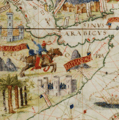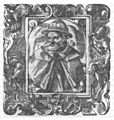Ajuran Sultanate facts for kids
Quick facts for kids
Ajuran Empire
Dawladdii Ajuuraan
دولة الأجورانية |
|||||||||||
|---|---|---|---|---|---|---|---|---|---|---|---|
| 13th century–late 17th century | |||||||||||
|
Flag
|
|||||||||||
| Capital |
|
||||||||||
| Common languages | Somali · Arabic | ||||||||||
| Religion | Sunni Islam | ||||||||||
| Government | Monarchy | ||||||||||
| Sultan, Imam | |||||||||||
| History | |||||||||||
|
• Established
|
13th century | ||||||||||
|
• First Ajuran-Portuguese war
|
1538–57 | ||||||||||
|
• Second Ajuran-Portuguese war
|
1580–89 | ||||||||||
|
• Oromo invasion
|
Mid-17th century | ||||||||||
|
• Decline
|
late 17th century | ||||||||||
| Currency | Ajuran • Mogadishan | ||||||||||
|
|||||||||||
| Today part of | |||||||||||
The Ajuran Empire was a powerful Somali empire that existed in medieval times. It was also known as the Ajuuraan Empire or simply Ajuran. This empire was a Muslim sultanate that ruled over large parts of the Horn of Africa during the Middle Ages.
The Ajuran Empire was very well-organized. It had a strong government and a powerful army. This allowed them to defend themselves against attacks, even from the mighty Ottoman Empire. They also fought several wars against the Portuguese and managed to hold their own. After these wars, trade routes became even stronger.
Trade was a huge part of the Ajuran Empire's success. Ships sailed to and from many places. These included kingdoms and empires in East Asia, South Asia, Europe, the Near East, North Africa, and East Africa. This made the coastal areas very rich.
Contents
Building a Strong Empire
The Ajuran Empire was very important in its time. Its rulers built many impressive castles and fortresses. You can still see some of these buildings today, especially in southern Somalia. They also built pillar tombs, cemeteries, and entire cities. Many of these are now in ruins, but they show how skilled Ajuran engineers were.
During the Ajuran period, many people in the southern Horn of Africa became Muslims. This was partly because the government was based on Islamic law. The royal family, called the House of Garen, grew their lands. They became very powerful by using a smart mix of fighting, trading, and making friends with other groups.
Controlling Water and Farming
The Ajuran rulers were also very good at managing water. They built wells and cisterns (water storage tanks) along the Shebelle and Jubba rivers. Many of these wells are still used today!
They also created new ways to farm and collect taxes. These systems were so good that some parts of the Horn of Africa used them until the 1800s.
Decline of the Empire
Later rulers of the Ajuran Empire were not as strong. People started to rebel against them. By the late 17th century, the empire began to fall apart. It broke into several smaller states. The most well-known of these new states was the Geledi Sultanate.
Images for kids
-
The Jubba River was vital for farming.
-
The walled city of Mogadishu shown on a 16th-century map.
-
Mogadishu traded for valuable gold coins from Europe.
-
The Ajuran Empire traded with the Ming dynasty and other kingdoms.
-
The medieval city of Barawa.
-
A 14th-century Somali-Arabo stone tablet.
-
Somali merchants from Mogadishu set up a trading post in Mozambique.
-
A model of a medieval Mogadishan ship.
-
During the Battle of Barawa, Tristão da Cunha was wounded.
-
In 1698, the Portuguese in Mombasa surrendered to a joint Somali-Omani force.
See also
 In Spanish: Sultanato Ajuran para niños
In Spanish: Sultanato Ajuran para niños




















